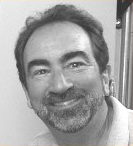 With the help of his dad, third-grader David Baughn took an empty toilet paper roll and wire to build a crystal set. As soon as he picked up a 50,000-watt clear channel radio station, the younger Baughn was hooked; broadcasting became his passion. Learning about Amateur (Ham) Radio, Baughn received his ham license at age 15. He was a member of Muscle Shoals Amateur Club where he served as club president for several years.
With the help of his dad, third-grader David Baughn took an empty toilet paper roll and wire to build a crystal set. As soon as he picked up a 50,000-watt clear channel radio station, the younger Baughn was hooked; broadcasting became his passion. Learning about Amateur (Ham) Radio, Baughn received his ham license at age 15. He was a member of Muscle Shoals Amateur Club where he served as club president for several years.
While attending University of North Alabama, and with little engineering experience, Baughn was hired by WOWL TV, where he quickly enhanced his engineering skills. There, he quickly became known as the “engineer who can fix things.”
Following a short stent as engineer for a mobile telephone service, Baughn was asked to return to WOWL where he became chief engineer, at age 26. After three years at the NBC affiliate, his long-time ham radio friend, Keith Barze, recruited him for the chief engineer position at the University of Alabama Center for Public Television (CPT).
The remainder of Baughn’s career was spent at the University of Alabama (1980-2014). While serving as chief engineer for CPT, Baughn accepted the challenge to apply for funding for a public radio station that would air from the UA campus. WUAL public radio became reality and Baughn later moved into a part-time engineering position for the radio station, allowing him time to assist in the start-up of commercial station WDBB Channel 17 in Tuscaloosa (Oct. 1984). WDBB was the first television facility to broadcast in stereo in Alabama, possibility in the nation. Broadcasting a stereo signal would have been impossible, since no stereo generator had been created…until Baughn built one. Serving as vice president and director of engineering for Channel 17, Baughn assisted in expanding that station into the Birmingham market by overseeing the construction of a 2,000-foot tower in north Tuscaloosa County. This tower became the second tallest structure in the free world.
Returning to CPT full-time, Baughn acquired a $1 million grant to completely renovate the television studio. The 1989 renovation moved the public television production center from the stone-age to the modern era. Always looking for the best opportunities in broadcasting for UA, Baughn told owners of another Tuscaloosa television license, that should they decided to sell their license, please consider gifting it to UA. The transfer occurred, and after acquiring funding, the full power Tuscaloosa station now broadcasts from the top of Red Mountain, in Jefferson County. Convincing the staff at the Federal Communications Commission to allow WVUA’s broadcast to move from south Tuscaloosa to Birmingham was one of Baughn’s major career accomplishments.
Baughn retired from UA in July of 2014. However, another of his major accomplishments occurred just before his retirement: Baughn oversaw the completion of a 15-year project that moved all UA television and radio broadcast facilities to a state-of-the-art digital media center located in Bryant-Denny Stadium in Tuscaloosa. As with Baughn’s other projects, going live was a success. However, the station’s debut from its new facility required last-minute changes; WVUA television was scheduled to sign on at 5 p.m., but a tornado in West Alabama required the staff to sign on two hours early.
Baughn is a partner of WJRD, the oldest radio station in Tuscaloosa, and in WMHZ, Tuscaloosa’s newest station.